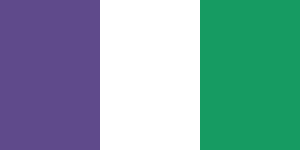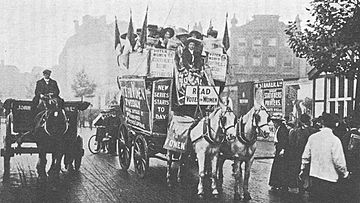Women's Social and Political Union facts for kids
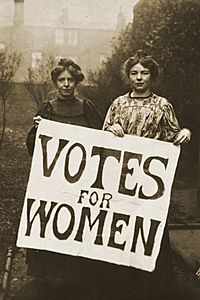
Annie Kenney (left) and Christabel Pankhurst, c. 1908
|
|
| Abbreviation | WSPU |
|---|---|
| Formation | 10 October 1903 |
| Founders | Emmeline Pankhurst Christabel Pankhurst |
| Founded at | 62 Nelson Street, Manchester, England |
| Dissolved | 1918 |
| Type | Women-only political movement |
| Purpose | Votes for women |
| Motto | "Deeds, not words" |
| Headquarters | |
| Methods | Demonstrations, marches, direct action, hunger strikes |
The Women's Social and Political Union (WSPU) was a group of women who fought for women's right to vote in the United Kingdom. They were active from 1903 to 1918. From 1906, they became known as the suffragettes.
The WSPU was led by Emmeline Pankhurst and her daughters, Christabel and Sylvia. They believed in taking strong action to achieve their goals. The WSPU members became famous for their acts of civil disobedience. This meant they broke laws on purpose to get arrested and draw attention to their cause. They held protests, marched, and even broke windows. When they were put in prison, they often went on hunger strikes.
Contents
The Fight for Votes: Early Years of the WSPU
The Women's Social and Political Union (WSPU) was started on October 10, 1903. It began at the Pankhurst family home in Manchester, England. Emmeline Pankhurst and her daughters, Christabel and Sylvia, were the main founders. They wanted an independent women's movement. Emmeline felt that other political groups were not doing enough for women. She invited women to her home, saying, "Women, we must do the work ourselves." Only women could join the WSPU, and it was not linked to any political party.
In 1905, the WSPU convinced a politician named Bamford Slack to propose a law for women's voting rights. This law did not pass, but it made the group grow quickly. After this, the WSPU changed its plan. They decided to challenge any political party that was in power. They would not support any new laws unless they included votes for women.
The word "suffragette" was first used in 1906 by a journalist to make fun of these women. But the women liked the name. They pronounced it "suffraGETtes" to show they were determined to "get" the vote.
In 1906, the WSPU started holding many protests and lobbying Parliament. This led to more and more members being arrested and sent to prison. About 300 women, representing over 125,000 suffragettes, met with the Prime Minister, Sir Henry Campbell-Bannerman. He agreed with their ideas but told them to "go on pestering" and be patient. This made the women very angry. Many had been fighting for women's rights for 50 years. His words made their strong actions even more determined.
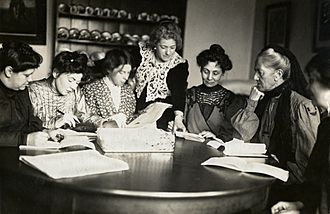
In 1907, the WSPU held its first "Women's Parliaments." Later, the Labour Party decided to support voting rights for all adults. This caused a disagreement with the WSPU. The WSPU wanted voting rights for women who owned property, like men did. Under Christabel's leadership, the group focused on middle-class women. They also decided to oppose all political parties. This led some members to leave and form a new group called the Women's Freedom League.
Developing the Campaign: New Strategies and Symbols
In late 1907, Frederick and Emmeline Pethick Lawrence started the WSPU's own newspaper, Votes for Women. They helped pay for and edit the newspaper for many years.
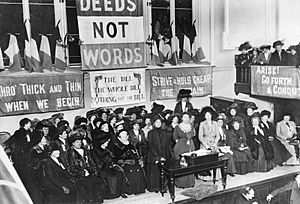
In 1908, the WSPU chose purple, white, and green as their official colours. Emmeline Pethick Lawrence explained their meaning:
- Purple stood for the "royal blood" in every suffragette.
- White stood for purity in private and public life.
- Green was for hope and new beginnings.
These colours were first used in a big way in June 1908. The WSPU held a huge rally called "Women's Sunday" in Hyde Park. About 300,000 people attended.
The WSPU also created the Woman's Press in 1907. This group handled all their publishing and advertising. From 1908, they sold many products with the WSPU name or colours. They had stores in London and across the UK. They even published a board game called Suffragetto around 1908. Their official song was "The Women's Marseillaise" until 1911. Then they changed it to "The March of the Women", a new song by Ethel Smyth.
Stronger Actions: Hunger Strikes and Protests
Many WSPU members were repeatedly sent to prison. To protest this, the WSPU started using hunger strikes in Britain. When suffragettes refused to eat, the authorities often force-fed them. This act of force-feeding gained a lot of public sympathy for the suffragettes.
The government then passed a law in 1913 called the "Cat and Mouse Act." This law allowed sick suffragettes to be released from prison. But once they were healthy, officers could arrest them again. This was a way to avoid force-feeding them to death in prison. In response, the WSPU created an all-women security team called the Bodyguard. They were trained in ju-jitsu by Edith Margaret Garrud. Their job was to protect suffragettes who were out of prison from being arrested again.
In 1910, a new law about voting rights was proposed. But the WSPU grew impatient. In 1912, they started a stronger protest campaign. They decided to target property, not people. At first, this meant smashing shop windows. But it grew to include setting fire to empty houses and churches. They also bombed public buildings, including Westminster Abbey. A special medal, the Hunger Strike Medal, was created by Sylvia Pankhurst. It was given to women who had gone on hunger strike or been force-fed.
Suffragettes also cut telephone lines and damaged greenhouses at Kew Gardens. They chained themselves to railings and even rushed the House of Commons. In July 1912, Mary Leigh threw a small axe at Prime Minister H. H. Asquith.
In February 1913, a bomb was set off at the home of David Lloyd George, a government official. The bomb damaged the house. Emmeline Pankhurst said she was responsible for the act. She was arrested and sentenced to three years in prison. She immediately went on hunger strike. The "Cat and Mouse Act" was quickly passed to make sure she did not die in prison.
Lloyd George wrote an article saying that the suffragettes' strong actions were hurting their cause. He believed that such actions made people less likely to support them.
In April, police raided the WSPU offices. Several women were arrested, including Flora Drummond and Rachel Barrett. They were found guilty of damaging property. In June 1913, Emily Davison was killed at the Epsom Derby horse race. She ran onto the track to try and attach a suffragette banner to the King's horse.
In March 1914, about 40 suffragettes fought with police in Glasgow. The police were trying to re-arrest Emmeline Pankhurst. The next day, Mary Richardson, known as "Slasher" Richardson, attacked a famous painting called Rokeby Venus with a meat cleaver in the National Gallery.
The WSPU also faced internal disagreements. The editors of Votes for Women, Frederick and Emmeline Pethick Lawrence, were removed in 1912. They then started a new group. The WSPU launched a new newspaper, The Suffragette. In 1914, the East London Federation of Suffragettes, a group of mostly working-class women led by Sylvia Pankhurst, was also separated from the WSPU.
The "Young Hot Bloods"
The "Young Hot Bloods," or "YHB," was a special group within the WSPU. It was made up of younger, unmarried women. Joining this group meant you were ready to take strong, direct action. The group was active from 1907 to 1913.
A writer named Fern Riddell described them as "the most dangerous suffragettes of all." The group was started in 1907 by Annie Kenney's sister Jessie and Adela Pankhurst. Their name came from a newspaper comment that said Mrs. Pankhurst would be followed by "younger and more hot-blooded members."
Some members of the group included Irene Dallas, Grace Roe, Jessie Kenney, Elsie Howey, Vera Wentworth, and Mary Home. The group became known to the public in 1913 when police found documents about them during raids. An inspector said in court that members had to be under 30 years old. After this, the "Young Hot Bloods" were not mentioned much in the news.
The WSPU During World War I
When the First World War began in 1914, Christabel Pankhurst was living in Paris. This was so she could lead the WSPU without being arrested. She made a big decision for the WSPU when the war started. She announced that the WSPU would stop its campaigns for votes. Instead, they would support the British government in the war.
The WSPU stopped printing The Suffragette newspaper. In April 1915, they started a new newspaper called Britannia. Most WSPU members supported the war effort. However, a small number formed new groups that continued to fight for women's voting rights. The WSPU slowly faded away and officially ended in 1917. Christabel and Emmeline Pankhurst then started a new group called the Women's Party.
Suffrage Drama and Comedy
Between 1905 and 1914, plays and theatre became very important for the women's movement. During this time, the WSPU became known for its strong actions. They moved from peaceful marches to more shocking "acts of violence." The group used these tactics to show how serious and urgent their cause was. Their actions included breaking windows, damaging museum paintings, setting fires, and cutting telegraph lines.
Playwrights who supported the suffragettes used their plays to fight the negative news about the movement. They tried to show that these acts of violence were a last resort. They wanted to change the idea that these protests were done by "irrational" or "overly-emotional" women. Instead, they showed that these actions were the only logical response to being denied a basic right.
Suffragettes also used comedy to their advantage. The WSPU was one of the first groups to use funny, satirical writing. This helped them calm down angry crowds and gain more supporters. Using satire allowed them to share their ideas and frustrations. It also helped them challenge unfair ideas about women in a safer way.
Suffrage speakers often held outdoor meetings to reach more people. They had to face unfriendly audiences and deal with interruptions. The best speakers learned to be quick-witted. They knew how to "always to get the best of a joke" and laugh with the audience, even if the joke was about them. Annie Kenney, a suffragette, remembered an old man who kept shouting, "If you were my wife I'd give you poison!" during her speech. She quickly replied, "Yes, and if I were your wife I'd take it!" This clever answer stopped the threats and made the man look silly.
Notable Members
- Mary Ann Aldham
- Janie Allan
- Doreen Allen
- Helen Archdale
- Ethel Ayres Purdie
- Barbara Ayrton
- Edith Marian Begbie
- Rosa May Billinghurst
- Teresa Billington-Greig
- Violet Bland
- Bettina Borrmann Wells
- Elsie Bowerman
- Janet Boyd
- Constance Bryer
- Lady Constance Bulwer-Lytton
- Evaline Hilda Burkitt
- Lucy Burns
- Eileen Mary Casey
- Joan Cather
- Georgina Fanny Cheffins
- Helen Millar Craggs
- Ellen Crocker
- Helen Cruickshank
- Louie Cullen
- Alice Davies
- Emily Davison
- Charlotte Despard
- Violet Mary Doudney
- Edith Downing
- Flora Drummond
- Sophia Duleep Singh
- Elsie Duval
- Norah Elam
- Dorothy Evans
- Kate Williams Evans
- Theresa Garnett
- Louisa Garrett Anderson
- Edith Margaret Garrud
- Katharine Gatty
- Mary Gawthorpe
- Katie Edith Gliddon
- Nellie Hall
- Cicely Hamilton
- Beatrice Harraden
- Edith How-Martyn
- Elsie Howey
- Ellen Isabel Jones
- Annie Kenney
- Edith Key
- Aeta Adelaide Lamb
- Mary Leigh
- Lilian Lenton
- Constance Lytton
- Mary Macarthur
- Florence Macfarlane
- Margaret Macfarlane
- Margaret McPhun
- Frances McPhun
- Margaret Mackworth, 2nd Viscountess Rhondda
- Christabel Marshall
- Kitty Marion
- Dora Marsden
- Lillian Metge
- Dora Montefiore
- Alice Morrissey
- Flora Murray
- Margaret Nevinson
- Edith New
- Adela Pankhurst
- Christabel Pankhurst
- Emmeline Pankhurst
- Sylvia Pankhurst
- Frances Parker
- Alice Paul
- Emmeline Pethick-Lawrence
- Ellen Pitfield
- Isabella Potbury
- Mary Richardson
- Edith Rigby
- Rona Robinson
- Mary Russell, Duchess of Bedford
- Bertha Ryland
- Amy Sanderson
- Arabella Scott
- Muriel Scott
- Genie Sheppard
- Alice Maud Shipley
- Dame Ethel Mary Smyth
- Harriet Shaw Weaver
- Evelyn Sharp
- Hope Squire
- Janie Terrero
- Dora Thewlis
- Catherine Tolson
- Helen Tolson
- Elsie and Mathilde Wolff Van Sandau
- Patricia Woodlock
- Gertrude Wilkinson
- Laura Ann Willson
- Laetitia Withall
- Olive Wharry
- Celia Wray
- Rose Emma Lamartine Yates
Images for kids
-
Portrait badge of Emmeline Pankhurst, c. 1909, sold by the WSPU to raise funds
See also
 In Spanish: Unión Social y Política de las Mujeres para niños
In Spanish: Unión Social y Política de las Mujeres para niños



